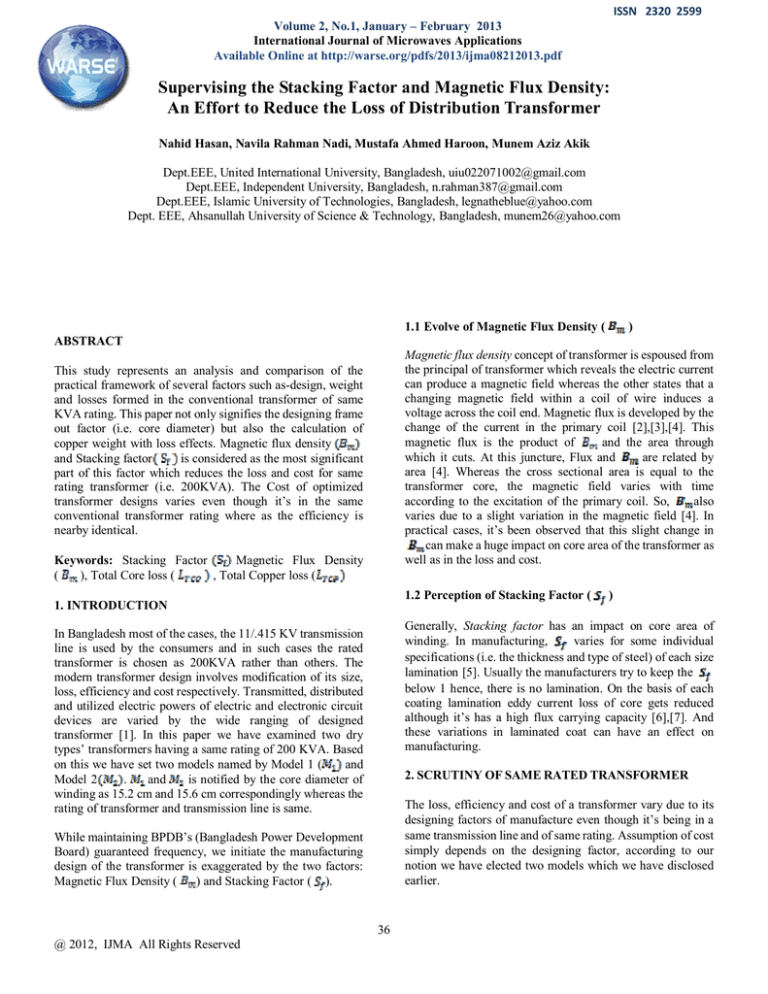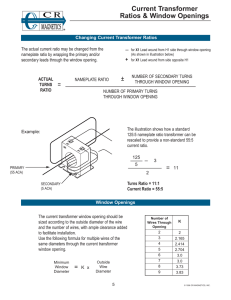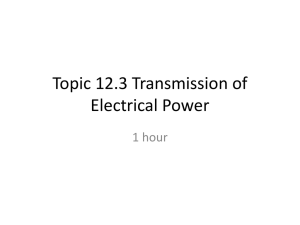
ISSN 2320 2599
Volume 2, No.1, January – February 2013
Nahid Hasan et al., International JournalInternational
of Microwaves
Applications,
2(1), January
– February 2013, 36 - 40
Journal
of Microwaves
Applications
Available Online at http://warse.org/pdfs/2013/ijma08212013.pdf
Supervising the Stacking Factor and Magnetic Flux Density:
An Effort to Reduce the Loss of Distribution Transformer
Nahid Hasan, Navila Rahman Nadi, Mustafa Ahmed Haroon, Munem Aziz Akik
Dept.EEE, United International University, Bangladesh, uiu022071002@gmail.com
Dept.EEE, Independent University, Bangladesh, n.rahman387@gmail.com
Dept.EEE, Islamic University of Technologies, Bangladesh, legnatheblue@yahoo.com
Dept. EEE, Ahsanullah University of Science & Technology, Bangladesh, munem26@yahoo.com
1.1 Evolve of Magnetic Flux Density (
)
ABSTRACT
Magnetic flux density concept of transformer is espoused from
the principal of transformer which reveals the electric current
can produce a magnetic field whereas the other states that a
changing magnetic field within a coil of wire induces a
voltage across the coil end. Magnetic flux is developed by the
change of the current in the primary coil [2],[3],[4]. This
magnetic flux is the product of
and the area through
which it cuts. At this juncture, Flux and
are related by
area [4]. Whereas the cross sectional area is equal to the
transformer core, the magnetic field varies with time
according to the excitation of the primary coil. So,
also
varies due to a slight variation in the magnetic field [4]. In
practical cases, it’s been observed that this slight change in
can make a huge impact on core area of the transformer as
well as in the loss and cost.
This study represents an analysis and comparison of the
practical framework of several factors such as-design, weight
and losses formed in the conventional transformer of same
KVA rating. This paper not only signifies the designing frame
out factor (i.e. core diameter) but also the calculation of
copper weight with loss effects. Magnetic flux density
and Stacking factor
is considered as the most significant
part of this factor which reduces the loss and cost for same
rating transformer (i.e. 200KVA). The Cost of optimized
transformer designs varies even though it’s in the same
conventional transformer rating where as the efficiency is
nearby identical.
Keywords: Stacking Factor
Magnetic Flux Density
(
), Total Core loss (
, Total Copper loss (
1.2 Perception of Stacking Factor (
1. INTRODUCTION
Generally, Stacking factor has an impact on core area of
winding. In manufacturing,
varies for some individual
specifications (i.e. the thickness and type of steel) of each size
lamination [5]. Usually the manufacturers try to keep the
below 1 hence, there is no lamination. On the basis of each
coating lamination eddy current loss of core gets reduced
although it’s has a high flux carrying capacity [6],[7]. And
these variations in laminated coat can have an effect on
manufacturing.
In Bangladesh most of the cases, the 11/.415 KV transmission
line is used by the consumers and in such cases the rated
transformer is chosen as 200KVA rather than others. The
modern transformer design involves modification of its size,
loss, efficiency and cost respectively. Transmitted, distributed
and utilized electric powers of electric and electronic circuit
devices are varied by the wide ranging of designed
transformer [1]. In this paper we have examined two dry
types’ transformers having a same rating of 200 KVA. Based
on this we have set two models named by Model 1 (
and
Model 2
.
and
is notified by the core diameter of
winding as 15.2 cm and 15.6 cm correspondingly whereas the
rating of transformer and transmission line is same.
2. SCRUTINY OF SAME RATED TRANSFORMER
The loss, efficiency and cost of a transformer vary due to its
designing factors of manufacture even though it’s being in a
same transmission line and of same rating. Assumption of cost
simply depends on the designing factor, according to our
notion we have elected two models which we have disclosed
earlier.
While maintaining BPDB’s (Bangladesh Power Development
Board) guaranteed frequency, we initiate the manufacturing
design of the transformer is exaggerated by the two factors:
Magnetic Flux Density (
) and Stacking Factor ( ).
36
@ 2012, IJMA All Rights Reserved
)
Nahid Hasan et al., International Journal of Microwaves Applications, 2(1), January – February 2013, 36 - 40
of core winding. The core diameter increases when there is a
gradual increase in the area. As well as the Loss, Efficiency
and cost also increases [8].
From this analysis we observe that the core area is inversely
proportional with
and .
A
1
1
and A
Sf
Bm
That means when
decreases the core area increases
gradually which makes an impact on loss, efficiency and cost.
Same goes for .
From our specified models we found that the core area of
=
and
whereas in both
cases =1.7,
0.96 and
0.93 correspondingly.
2.2 Impact of copper weight of transformer
Figure 1: Designing factors of manufacturing
The Copper weight increases when the core area of winding
gets expand. This copper weight makes an impact on loss,
efficiency and cost including payback of transformer. In this
section, the cost of copper winding is expressed as a function
of copper weight which is directly related with the
transformer windings (i.e. LT and HT windings). In
and
, we found that the total weight of copper is 130.79 kgs and
133.37 kgs respectively.
Figure 1 shows that these models are processed inherit on
three factors (i.e. designing frame out, Loss and Weight of
Copper). From this we can conclude to our result which
divulges whether it is cost effective or not. Those factors are
briefly discussed furthermore.
2.1 Feature of Designing Frame out
The different manufacturing features opt for customers’
requirement. Figure 2 shows the operation of designing frame
out factor.
2.3 Behavior of Losses (Copper and Core)
We originate that, the Copper Losses are summarized by the
windings due to getting different values of copper weight for
our models in previous section. We sum up the copper losses
from measuring winding (i.e. LT and HT) losses separately.
These losses were cross product by the temperature factor
through which we ascertained
that are 2687.32 and 2709
watts (respectively) for our mentioned models.
N.B: BPDB’s guaranteed copper loss is 2820 watts at 750
Celsius and the manufactures try to maintain their ratings
close to it.
In the case of Core Losses, by the cross product of total core
weight, loss and workman ship per kg. The total weight of
core is the summarization of weight of yoke and limb. These
weights of yoke and limb depend on basically window height,
maximum yoke length and core area. Here, core losses for
watts and
399 watts.
Figure 2: Designing Frame out Factor of a transformer
N.B: BPDB’s guaranteed copper loss is 2820 watts at 750
Celsius and the manufactures try to maintain their ratings
close to it.
Due to the requirement of customer we get to know about the
rating of transformer and transmission line. According to
those values, voltage per turn is being set. From this we can
find the gross core area. While calculating the gross core area,
it’s been seen that gross core area depends on
and .
Afterwards the net core area is linked by the gross core area
and . Therefore, we find the diameter ( i.e inner and outer)
At last, through adding up the copper and core losses the total
loss of transformer is found. In this case, 10% tolerance is
taken as granted.
37
@ 2012, IJMA All Rights Reserved
Nahid Hasan et al., International Journal of Microwaves Applications, 2(1), January – February 2013, 36 - 40
N.B: This calculation is applicable for both LT and HT
windings.
3. ESTIMATION OF DESIGN CONCERN
In the basis of our two models according to the methodology
we compute the following factors:
C. Loss
A. Designing frame out factor
Voltage per turns,
(volts)
Total loss is computed here through summarizing the copper
and core losses together.
Here,
Constant (0.4 to 0.45)
Gross Core Area,
(
Rating of
Transformer
)
Net Core Area,
)
Core Diameter,
(cm)
Copper Loss
Resistance/ Phase R =
Loss/Phase =
= Voltage per turns
(Ω)
Total loss in 3 Ǿ =
Frequency
(watt)
Total Copper loss= Copper loss in (HT+LT) windings (watts)
= Flux density
Total Copper loss at 750C,
= Stacking factor
=
Here, r = 0.019 (resistance/m2)
Key factor,
Now,
LT coil inside diameter,
Core Loss
Weight of Yoke,
(cm)
( kgs)
LT coil outside diameter,
+(
(
)+
Weight of limb,
)+
(kgs)
Total weight of core,
(cm)
( kgs)
Total Core loss,
HT Coil inside Diameter,
(cm)
(cm)
Total loss =
Mean diameter of (LT+HT) Winding,
4. NOTEWORTHY IMPACT
(cm)
In this paper, we appraise the impact of
by fixing
the core diameter (in case of
and
). From the following
Table1, we can distinguish the variation of
from 1.7-1.5
along with the range of
from 0.99-0.93 for fixed core
diameter.
Window height,
(cm)
= (2 Limb center + maximum
SI
No
B. Copper Weight extent
1
Length of mean turns,
Weight of Winding per Phase,
Total weight of winding,
Total weight of Copper = Total weight of (HT +LT) windings
per kg
Here,
Area of copper
No. of turns
Density of copper
2
3
4
5
38
@ 2012, IJMA All Rights Reserved
(watts)
Here, Core loss per kg = 0.9 watt
Workman ship per kg =1.45 watt.
HT Coil outside diameter,
Maximum yoke length,
width of core) (cm)
(Ω)
Table 1: Attributes of fixed diameter
Magnetic
Stacking
Core
flux
factor
Diameter
(D)
( )
(
)
1.7
0.96
15.2
0.93
15.6
1.65
0.97
15.25
0.95
15.6
1.6
0.99
15.2
0.96
15.6
1.55
0.98
15.6
1.5
0.99
15.6
Nahid Hasan et al., International Journal of Microwaves Applications, 2(1), January – February 2013, 36 - 40
Figure 3 describes the characteristics of
. To keep
the diameter fixed, at 10% (almost) change of
,
changes in a rate of 3 % .
Figure 3: Characteristics of
1
2
Table 2: Impact of
and A on D
Magnetic Stacking
Gross
Net
flux
factor
Core area
Core area
(A)
( )
(
)
(
)
1.7
0.99
168.61
169.86
0.98
170.33
173.81
0.97
172.09
177.41
0.96
173.88
181.12
0.95
175.71
184.95
0.94
177.58
188.91
0.93
179.496
193.01
1.65
0.99
173.73
175.48
0.98
175.5
179.08
0.97
177.31
182.79
0.96
179.16
186.63
0.95
181.04
190.57
0.94
182.97
194.65
0.93
184.94
198.86
1.55
5
1.5
6
1.45
7
1.4
0.99
0.98
0.97
0.96
0.95
0.94
0.93
0.99
0.98
0.97
0.96
0.95
0.94
0.93
0.99
0.98
0.97
0.96
0.95
0.94
0.93
0.99
0.98
0.97
0.96
0.95
0.94
0.93
0.99
0.98
0.97
0.96
0.95
0.94
0.93
179.156
180.98
182.85
184.75
186.69
188.68
190.71
184.94
186.82
188.75
190.71
192.72
194.77
196.87
191.1
193.05
195.04
197.07
199.15
201.26
203.43
197.69
199.71
201.77
203.87
206.01
208.21
210.44
204.75
206.83
208.97
211.14
213.17
215.64
217.96
180.96
184.67
188.5
192.45
196.51
200.72
205.06
186.81
190.63
194.59
198.66
202.86
207.2
211.69
193.03
196.99
201.07
205.28
209.63
214.11
218.74
199.69
203.79
208.01
212.36
216.85
221.5
226.78
206.82
211.1
215.43
219.93
222.38
229.4
234.36
15.2
15.3
15.4
15.6
15.8
15.9
16.1
15.4
15.6
15.74
15.9
16.1
16.24
16.42
15.6
15.8
15.9
16.1
16.3
16.5
16.6
15.9
16.1
16.3
16.4
16.62
16.8
16.99-17
16.2
16.3
16.5
16.7
16.8
17
17.2
5. CONCLUSION
Figure 5 pretends the block diagram of variable dependency
on loss upon cost. From this diagram we can understand that
the characteristic of loss, payback & efficiency and cost which
are merely dependent on
for our precise models.
Whereas we saw
, loss and cost will be decreased
hence
, payback & efficiency is saturated or vice versa.
Core
Diameter
(D)
14.7
14.8
15
15.2
15.3
15.5
15.6
14.95
15.1
15.25
15.42
15.6
15.74
15.91
Figure 5: Emphasis of
upon D
From Table 3, we summarize that, for
due to a change in
and
the core loss as well as the total loss varies. In the
followed equation we sum up the core losses with the copper
losses of the value 2867.32 (watts). On this basis, we found
the variation of total loss.
39
@ 2012, IJMA All Rights Reserved
4
upon D
In earlier section we have observed the effects of
and
on particular diameters. Also from this we analyze that the net
core area and gross core area changes due to
and
consequently core diameter is calculated from the net and
gross core area. The following Table 2 shows the fact.
SI
No
1.6
and
Core diameter, D will be decreased at that point when
gets
increased. We observe this phenomenon from the following
Figure 4. When
to 1, D must be decreased that
means the lamination of core is contaminated.
Figure 4: Emphasis of
3
Nahid Hasan et al., International Journal of Microwaves Applications, 2(1), January – February 2013, 36 - 40
Table 3: Impact of Core Loss for
Magnetic
flux (
)
1.6
1.65
1.7
Core
Diameter (D)
15.2 cm
Stacking
factor ( )
0.96
0.97
0.96
Core Loss
3.
391(watt)
386(watt)
379(watt)
4.
=3078.32(watts)
=3073.32(watts)
=3066.82(watts)
5.
For
due to a change in
and
the core loss as well
as the total loss varies which has disclosed in Table 4. In the
followed equation we encapsulate the core losses with the
copper losses of the value 2709 (watt). We found the variation
of total loss based on this.
6.
7.
Table 4: Impact of Core Loss for
Magnetic
flux (
)
1.6
1.65
1.7
Core
Diameter(D)
15.6 cm
Stacking
factor ( )
0.96
0.95
0.93
Core Loss
8.
410.67(watt)
402.42(watt)
399(watt)
9.
=3119.67(watt)
=3111.42(watt)
=3108(watt)
10.
According to our calculation we found the variation of total
losses. Here, we concoct that if we set
as 0.96 whereas
in the range of (1.6-1.7), loss will remain same. Hence,
we can get an average quality of efficiency with minimum
cost including minimum losses.
11.
3119.67-3078.32=41.35(watt)
3111.42-3073.32=38.1(watt)
3108-3066.82 =41.18(watt)
12.
ACKNOWLEDGEMENT
13.
To implement our concept we used practical data and
assembled two same rated transformer models for same
transmission line having same no of turns while the core
diameters is different.
14.
REFERENCES
1.
2.
G. Builder, I. C. Hansen and F. Langford-Smith.
Transformers & iron-cored inductors, RCA, Radiotron
Designers Handbook, 4th ed., ch. 5.
Mauricio Valencia Ferreira da Luz and Patrick Dular.
Analysis of High Frequency power Transformer
Windings for leakage Inductance Calculation,
40
@ 2012, IJMA All Rights Reserved
GRUCAD/EEL/CTC,
CP,
476,
88040-900,
Florianopolis, SC.
Guemes-Alonso, J. Antonio. A New Method for
Calculating of Leakage Reactances and Iron Losses in
Transformers, in proc. Fifth International Conference
on Electrical Machines and Systems, 2001. ICEMS
2001 , vol.1, pp.178-181 vol.1, 18-20 Aug. 2001
John Frederic Whitfield, Electrical craft principles, 4th
Edition, vol.2.
D. P. Kothari, I .J. Nagrath, Electric Machines 4e, Tata
McGraw Hill Education Private Limited,7 West Patel
Nagar,New Delhi 110008, ISBN-13:978-0-07-069967-0,
ISBN-10:0-07-069967-4, pp. 15-20.
Kuldeep Sahay, Shivendra Pathak, Kuldeep Sahay,
Basic Concepts Of Electrical Engineering , New Age
International Publishers, Copyright 2006, New Age
International (P) Ltd., ISBN:81-224-1836-8, pp. 80-83.
Bhel, Transformers,2nd ed., Tata McGraw-Hill
Publishing Company Limited, 7
West Patel Nagar,
New Delhi 110008, ISBN-13:978-0-07-048315-6,
ISBN-10:0-07-04835-9, pp. 85-8.
Indrajit Dasgupta, Design Of Transformers, Tata
McGraw-Hill Publishing Company Limited, 7
West
Patel Nagar, New Delhi 110008, Typeset at Script
Makers 19,A1-B DDA Market, Paschim Vihar, New
Delhi
110063,
ISBN-13:978-0-07-043640-4,
ISBN-10:0-07-043640-1, pp. 62-67
K B Raina, S.K. Bhattacharya, Electrical Design
Estimating And Costing, New Age International (P)
Ltd., 4835/24, Ansari Road, Daryaganj, New
Delhi-110002, ISBN:81-224-0363-8,pp.362-367.
Ewald Fuchs, Mohammad A. S. Masoum, Power Quality
in Power Systems and Electrical Machines, Elsevier
Academic press, 30 Coporate Drive, Suite 400,
Burlington, MA 01803, USA 525 B Street, Suite 1900,
San Diego, California 92101-4495, USA 84 Theobald’s
Road,
London
WCIX
8RR,
UK.
ISBN:
978-0-12-369536-9, pp. 172-177.
Martin J. Heathcote. The J & P transformer book,
Oxford University Press,Newnes, 1998, pp.179.
Man Mohan and Puneet Kumar Singh, Distribution
Transformer with Amorphus-CRGO Core: An Effort
to Reduce the Cost of Amorphous Core Distribution
Transformer, ARPN Journal of Engineering and
Applied Science, vol.7, No.6, ISSN 1819-6608.
Man Mohan, Amorphous-Core Transformer with
Copper Winding Versus Aluminium Winding-A
Comparative Study, ARPN Journal of Science and
Technology, vol.2, No.4, ISSN 2225-7217.
SMITH W.F. Principles of materials science and
engineering, (McGraw-Hill Series in Materials Science
and Engineering, 1986).






